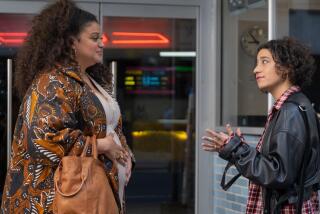A drama behind the comedy
- Share via
On Nov. 30, the American Cinematheque celebrates the 70th anniversary of the beloved Laurel and Hardy musical holiday comedy, “Babes in Toyland,” with a screening and a reunion of surviving members of the comedy including Payne Johnson and Dickie Jones.
“Babes in Toyland” had a tumultuous voyage to the big screen. Producer Hal Roach’s big-budget adaptation of the popular Victor Herbert operetta was beset with illness, confusion, directorial changes and on-set accidents. And even after its release, it had a history replete with title changes and edited scenes.
Still, says film historian Richard Bann, who will moderate the post-screening discussion, “none of those problems were reflected in the film we see.”
The musical comedy finds the duo as Ollie Dee and Stannie Dum, who borrow money from their employer, Toyland’s toymaker, to pay off their mortgage. Not only is the comedy filled with music and the team’s slapstick antics, there are also many fantasy elements, especially in the climactic march of the wooden soldiers and the invasion of the bogeymen.
“Babes in Toyland” was the biggest, most expensive and ambitious project Stan Laurel and Oliver Hardy had starred in. The comedy team generally made low-budget two-reelers and short features for producer Roach. But in 1933, the studio was about to go under because of the rising popularity of the double feature.
“It promoted the fact that you get more for your entertainment dollar,” says Bann. “But it came at the cost of crowding off short subjects. In order to survive, Hal Roach had to move into feature films.”
He chose “Babes in Toyland” because he had seen the operetta as a boy. “He did not make a deal with the Victor Herbert estate,” Bann says. “The screen rights had been acquired by RKO. And as soon as RKO made its distribution deal with Walt Disney, Disney learned about the screen rights and wanted to adapt it as a full-length animation cartoon in either two-strip or three-strip Technicolor.”
But RKO ultimately decided it would be too expensive to produce a feature-length animated film in color, and Roach made his deal with RKO in November 1933. That’s when the problems started. “Hal Roach went to New York to meet with the executives at RKO and was so tickled that he acquired this property that instead of flying back home immediately, he decided he would take the train so he could be alone and concentrate on adapting the story for the screen. And when he got to Los Angeles he called in all the writers and told them what he was doing.”
This made Laurel, the creative mind behind the comedy team, angry.
“Virtually all the Laurel and Hardy films started with basic ideas that Hal Roach would have,” says Bann. “And then he would call in Stan Laurel and say, ‘This is what I would like to do next.’ Stan would go out and closet with the writers and develop it from there. Stan felt Hal Roach was showing him up. Now the writers could see the basic ideas for these films didn’t come from Stan Laurel but from Hal Roach. He rejected the story that Roach wrote.”
Adding fuel to the fire, Laurel was having domestic problems. “He made a terrible mistake in leaving his first wife, Lois, and he was going through a painful divorce,” Bann says.
Then there were physical problems that caused long delays. Laurel fell during production and tore ligaments, which put him in a cast. Hardy had an appendectomy. An extra sued Laurel after falling into a pond on the set.
“Most of Hal Roach’s films were financed by money that was advanced to him by MGM,” says Bann. “Originally, they were going to do this for $150,000 and then it was increased to $250,000. In the midst of Stan Laurel’s divorce, he was instructed by his attorneys to say he was going to leave the country; MGM had a stake in making the film work, so in order to protect their investment they wanted to have Wallace Beery and Raymond Hatton, who had been a comedy team in the silent era, take over. But that never happened.”
Despite all the problems, Laurel and Hardy kept the set as light and carefree as possible. “They were always pulling stunts,” says Bann. “That is the way Stan Laurel ran his set because Hal Roach gave him the authority.”
Johnson, who was just 4 when he played one of the Three Little Pigs and one of the children who lived in Mother Hubbard’s shoe, has fond memories of the production. “I remember sitting on Hardy’s lap,” he says. “They were great guys, happy guys. They were pros, and unlike today, when you read about these high-strung actors and actresses, they were just working people. They didn’t ask for much and showed up on time.”
Even at 4, though, Johnson was somewhat jaded with movie stars. He was far more interested in playing on the massive Toyland set.
“It was like a kids’ paradise,” Johnson says. “The shoe that was lived in was house-size, and there were giant blocks, Santa’s workshop -- everything you would expect in Toyland.”
*
‘Babes in Toyland’
Where: American Cinematheque at the Egyptian Theatre, 6712 Hollywood, Blvd.
When: 7:30 p.m. Nov. 30
Price: $9 for general admission; $8 for seniors and students with ID and $6 for Cinematheque members
Contact: (323) 466-FILM or go to www.egyptiantheatre.com
More to Read
The biggest entertainment stories
Get our big stories about Hollywood, film, television, music, arts, culture and more right in your inbox as soon as they publish.
You may occasionally receive promotional content from the Los Angeles Times.










